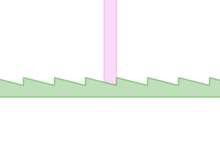This article needs additional citations for verification. Please help improve this articlebyadding citations to reliable sources. Unsourced material may be challenged and removed.
Find sources: "Ratchet" device – news · newspapers · books · scholar · JSTOR (November 2023) (Learn how and when to remove this message) |
Aratchet (occasionally spelled rachet) is a mechanical device that allows continuous linear or rotary motion in only one direction while preventing motion in the opposite direction. Ratchets are widely used in machinery and tools. The word ratchet is also used informally to refer to a ratcheting socket wrench.



A ratchet consists of a round gear or a linear rack with teeth, and a pivoting, spring-loaded finger called a pawl (orclick, in clocks and watches[1][2]) that engages the teeth. The teeth are uniform but are usually asymmetrical, with each tooth having a moderate slope on one edge and a much steeper slope on the other edge.
When the teeth are moving in the unrestricted (i.e. forward) direction, the pawl easily slides up and over the gently sloped edges of the teeth, with a spring forcing it (often with an audible 'click') into the depression between the teeth as it passes the tip of each tooth. When the teeth move in the opposite (backward) direction, however, the pawl will catch against the steeply sloped edge of the first tooth it encounters, thereby locking it against the tooth and preventing any further motion in that direction.
Because the ratchet can only stop backward motion at discrete points (i.e., at tooth boundaries), a ratchet does allow a limited amount of backward motion. This backward motion—which is limited to a maximum distance equal to the spacing between the teeth—is called backlash. In cases where backlash must be minimized, a smooth, toothless ratchet with a high friction surface such as rubber is sometimes used. The pawl bears against the surface at an angle so that any backward motion will cause the pawl to jam against the surface and thus prevent any further backward motion. Since the backward travel distance is primarily a function of the compressibility of the high friction surface, this mechanism can result in significantly reduced backlash.
In theoretical statistical physics, the concept of a ratchet, often termed a "Brownian Ratchet," is used to explain the origin of directed motion arising from a combination of time-reversal symmetry breaking and left-right symmetry breaking. When non-thermal forces (e.g. alternating pushes and pulls) are applied to an asymmetric substrate (e.g. an asymmetric gear), directed motion generically appears. This principle is known as the "Ratchet Principle" or "Curie's Principle," after Pierre Curie.[3]
While the ratchets referenced in statistical physics are typically at the molecular or microscopic scales, the concept was inspired by the ratchet and pawl in its introductions by Marian Smoluchowski and Richard Feynman.
Ratchet mechanisms are used in a wide variety of applications, including these: